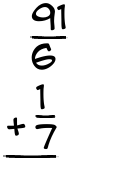What is 91/6 + 1/7?

|
Here's how to add
|
|||||||||||
Step 1We still have different denominators (bottom numbers), though, so we need to get a common denominator. This will make the bottom numbers match. Multiply the denominators together first. Now, multiply each numerator by the other term's denominator. Now we multiply 91 by 7, and get 637, then we multiply 6 by 7 and get 42. Now for the second term. You multiply 1 by 6, and get 6, then multiply 6 by 7 and get 42. This gives us a new problem that looks like so:
|
|||||||||||
Step 2Since our denominators match, we can add the numerators. 637 + 6 = 643 That gives us an answer of
|
|||||||||||
Step 3Can this fraction be reduced? First, we attempt to divide it by 2... Nope! So now we try the next greatest prime number, 3... Nope! So now we try the next greatest prime number, 5... Nope! So now we try the next greatest prime number, 7... Nope! So now we try the next greatest prime number, 11... Nope! So now we try the next greatest prime number, 13... Nope! So now we try the next greatest prime number, 17... Nope! So now we try the next greatest prime number, 19... Nope! So now we try the next greatest prime number, 23... Nope! So now we try the next greatest prime number, 29... Nope! So now we try the next greatest prime number, 31... Nope! So now we try the next greatest prime number, 37... Nope! So now we try the next greatest prime number, 41... Nope! So now we try the next greatest prime number, 43... No good. 43 is larger than 42. So we're done reducing. There you have it! Here's the final answer to 91/6 + 1/7
|